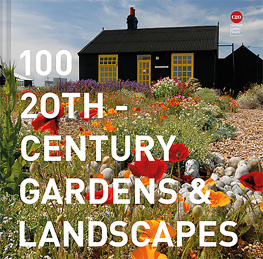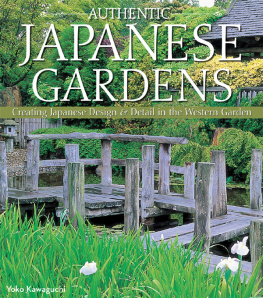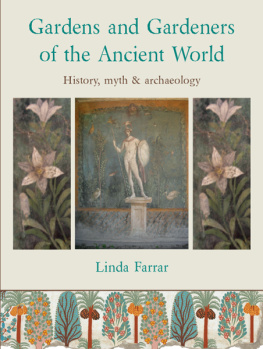About the Author
Victoria M. Siu (1935-2010), a member of the Religious of the Sacred Heart, U.S. province (RSCJ), held a Ph.D. from Georgetown University where her dissertation was on U.S.-Chinese relations. When she inherited her fathers research on the Qianlong gardens she taught herself horticultural history and architecture with the help of an NEH summer grant and a year-long grant at Dumbarton Oaks, Washington, D.C. She perfected her classical Chinese, Italian, and French, and consulted and visited garden scholars in China, Japan, Europe and the United States. For eighteen years she taught Asian studies at the University of San Francisco.
Acknowledgments
I have many debts to acknowledge since I first started working on the Garden of Perfect Brightness almost twenty years ago. My first obligation is to acknowledge my father, Professor John Tchoan-pao Siu, Ph.D. () whose own professors of International Law at the University of Paris, Sorbonne, in the early twentieth century, lamented the imperial gardens destruction. They encouraged my father to reveal the gardens original magnificence in book form to a Western audience. Upon his death, my family unfailingly supported my endeavors to complete his study. (My fathers original study included a major section on the fate of the looted art objects removed from those premises immediately before the 1860 conflagration. That study remains to be done.)
Thanks to Routledge for allowing me to publish parts of my article, China and Europe Intertwined: A New View of the European Sector of the Changchun Yuan, which appeared in the July-December 1999 issue of Studies in the History of Gardens and Designed Landscapes.
I would like to acknowledge Professor Yang Boda () at the National Palace Museum, Beijing. In 1989, he was kind enough to endorse my research project which was instrumental in getting the book started.
For their constant inspiration and unfailing support in my endeavors, I am indebted to Ellen Johnston Laing (University of Michigan), Terese Tse Bartholomew (Asian Art Museum of San Francisco), and Kathleen L. Lodwick (Pennsylvania State University, Lehigh Valley) who have been instrumental in bringing this book to fruition.
I would also like to thank Paul Rule (Latrobe University, Melbourne) and So Kam Ng (De Anza College and Asian Art Museum of San Francisco) for editing the final draft and offering insightful contributions; Lorna Dittmer for her discerning eye in final proofreading; and John Bansavich (ITS, University of San Francisco) for his technological expertise.
Akira Sato (Parks and Open Space Association of Japan), Michel Conan and the garden fellows (Dumbarton Oaks), and Zhao Guanghua (Garden of Perfect Brightness expert, Beijing) lent their special knowledge and expertise to the book.
With patience, accessibility to information was generously given to me by Fred Cline and John Stucky (Asian Art Museum of San Francisco Library), Patrick P. K. Tseng and the staff (Library of Congress, Chinese and Korean Section), and Mark Stephen Mir (Ricci Institute, University of San Francisco).
Many individuals and institutions have been very generous with funding and grants over the years. J. S. Lee of the Bei Shan Tang Foundation and the U.S. province of the Religious of the Sacred Heart have been crucial in allowing me to gather invaluable information firsthand. The University of San Francisco aided me with monetary contributions. A Dumbarton Oaks Fellowship (1999-2000) offered me the opportunity to complete drafts and gather necessary peer reviews. An NEH summer grant also helped.
Finally, special thanks are also due to Scott Paul Gordon (director, Lehigh University Press) and Judith Mayer, his assistant.
Victoria M. Siu
(1935-2010)
**************************************************************
Gardens of a Chinese Emperor: Imperial Creations of the Qianlong Era, 1736-1796 was the scholarly work of Dr. Siu for many years which took her to three continents in search of elusive sources for this monograph. It is now her legacy to the scholarly world. Her meticulous attention to detail and to getting it right is what all scholars should possess. Her Georgetown dissertation was in the field of U.S.-China relations, so to work on this monograph she had to teach herself garden history and architecture, while perfecting her knowledge of classical Chinese, French, and Italian, and constantly revising her ideas and writing. She was also a conscientious teacher at several universities.
While this book was undergoing the final proofreading, Dr. Siu became ill and was unable to make the final corrections for publication. With the unfailing support of Dr. Sius sisters, Moyra Siu Moy and Clare Siu, both also doctors, but in their cases M.D.s, and her religious sisters of the Congregation of the Sacred Heart, I have undertaken to make final corrections, label the plates, extract the terms in the Glossary from the text, prepare the Index, and generally guide the manuscript through the publication process. Any mistakes and/or omissions are unintentional, and we hope will be forgiven.
Pamela Kyle Crossley, Robert 1932 and Barbara Black Professor of History, Dartmouth College, Dartmouth, New Hampshire, who knows the Qing period so well through her own work, graciously agreed to proofread the Chinese and provide transliterations and translations in the cases where they were missing so that the glossary could be created. Without her help, this book could not have been completed and my thanks to her are boundless. She was assisted by two post-doctoral fellows working with her during the 2009-2010 academic year: Wang Lizhen, National Minorities University, Beijing; and Li Shizong, East China Normal University, Shanghai. Both Te Mule (Temur), associate professor of History, University of Nanjing, (occasionally with the help of his colleagues), and Xi Lian, professor of history Hanover College, kindly provided me with characters, which sometimes went missing; answered endless questions; and provided much encouragement. Te Mule also read the entire manuscript. Robert Harrist, professor of art history, Columbia University, also offered kind assistance. Vera Mark, assistant professor of French and Francophone Studies, Pennsylvania State University, University Park, proofread the French, Italian, and Latin references in the Bibliography. Ms. Zhang Ying at the Palace Museum, Beijing, offered kind assistance. Donna Hahn, administrative assistant, Pennsylvania State University, Lehigh Valley Campus, and Anne Marie Fullington proofread the manuscript. Many of Dr. Sius friends whom I encountered at the Harvard University, Fairbank Center/Peabody Essex Museum Symposium on Chinese gardens in 2010 and at the Association for Asian Studies meetings offered encouragement out of their affection for Vicky. I also wish to thank both Scott Paul Gordon, professor of English and former director; Monica Najar, associate professor of history and current director, and Judith Mayer all of Lehigh University Press for their patience and assistance as I undertook this task. I also wish to thank the staff of Rowman and Littlefield which now publishes Lehigh University Press books.
It is with permission of Moyra and Clare Siu that I add the note that their father Professor John Tchoan-pao Siu, Ph.D. () was the descendant of a long line of Confucian scholars, for which the Suzhou region was famous in dynastic times. His scholarly work, as well as his daughter Victorias, was the continuation of that tradition of scholarship. As I retired from my lifetime career of teaching, researching, and writing about China, I feel honored to have helped complete their work.
November 2012
Kathleen L. Lodwick
Professor of History, Emerita
Pennsylvania State University
Afterword






